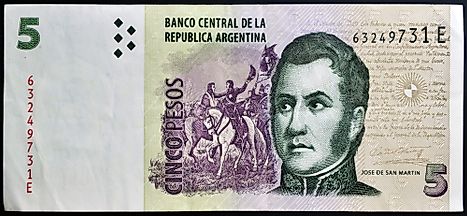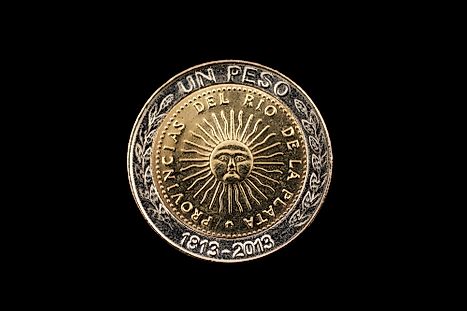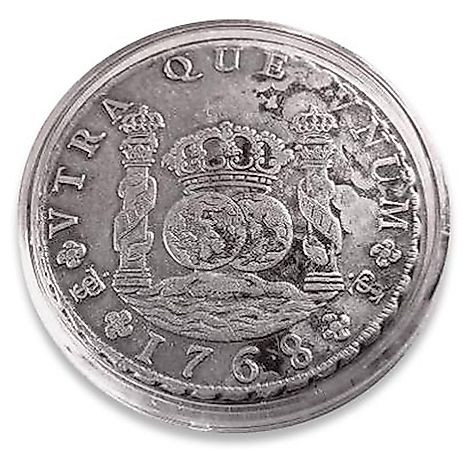Flags, Symbols & Currency of Argentina
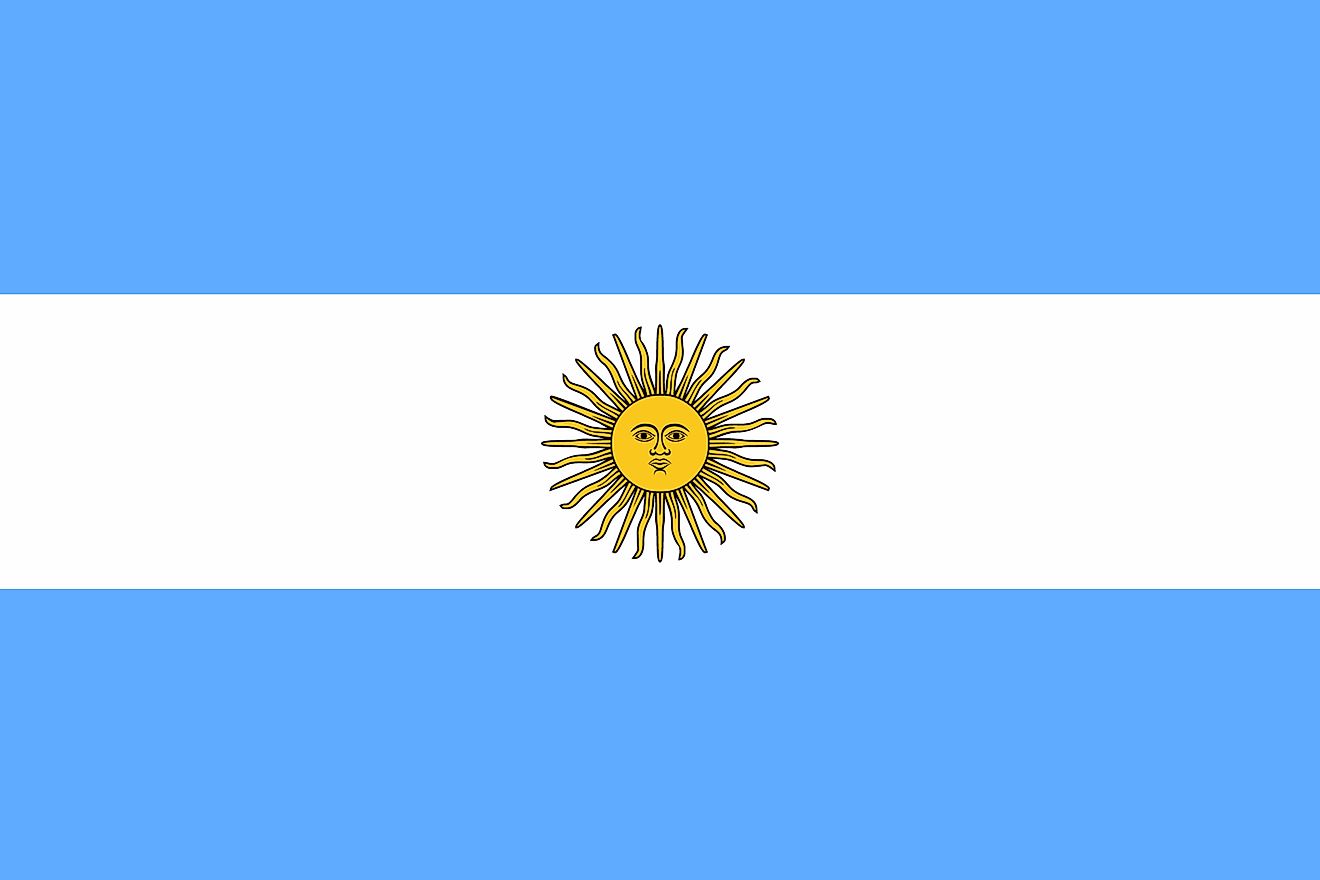
The Argentine Flag (La Bandera) was created and first raised on February 27, 1812, four years before Argentina declared independence from Spain. The current National flag was officially adopted on July 20, 1816, shortly after the declaration of independence. The flag was designed in the early 19th century, by General Manuel Belgrano – an Argentinean politician and military leader as well as an influential figure in the Argentine Wars of Independence.
The Argentinean national flag has three equal horizontally-running bands of light-blue, white, and sky blue colors arranged from top to bottom. Centered in the white band of the national flag is the Inca Sun - a radiant yellow sun which has the likeness of a human face and is known as the Sun of May (el Sol de Mayo). This Sun of May was added to the flag in 1818 and pays tribute to the Incan sun deity, Inti who was revered and worshiped by the ancient native Inca inhabitants. The light blue stripes upon a white field are said to be symbolic of the clear skies (“celeste”) and the snow of the Andes. The sun symbol commemorates the appearance of the sun through cloudy skies on 25 May 1810 during the beginning of the first mass demonstration in favor of the country’s Independence. The flag has a height to length proportion ratio of 9:14.
The full flag featuring the sun is called the Official Ceremonial Flag (Bandera Official de Ceremonia) and the flag without the sun is called the Ornamental Flag (Bandera de Ornato).
History of the Argentine Flag
On February 18, 1812, the First Triumvirate instituted The Argentine Cockade as a national symbol, which was created by Manuel Belgrano. This success encouraged him to also design the national flag that was first flown on February 27, 1812. The flag was hoisted for the first time in Buenos Aires on August 23, 1812. The flag was finally declared to be the official national flag by the Congress of Tucumán on July 20, 1816, shortly after the declaration of independence. According to a decree which stated that the Official flag of the Nation is the flag with the sun in its center, as approved by the Congress and reunited with Buenos Aires on February 25, 1818. In 1861, the current version of the flag was adopted and the standardization was done in 2012.
Symbols of Argentina
National Coat of Arms of Argentina
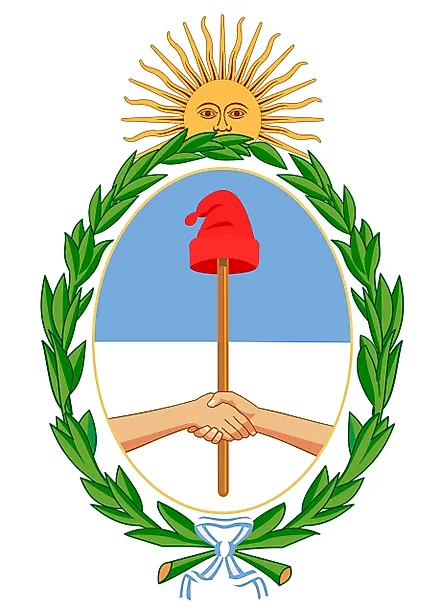
The Argentinean coat of arms/emblem was officially adopted in 1813 and properly described in 1944. At the top of the Argentinian coat of arms is the golden Sun of May, signifying Argentina as a new and glorious nation rising to the surface of the Earth. The red cap at the top of the brown spike is the Phrygian cap symbolizing liberty. The two shaking hands symbolize the unity of the different provinces of Argentina. The blue and white colors behind the coat of arms symbolize the Argentinian people and the beautiful land they inhabit. The spike under the cap represents the people's willingness to defend their land and protect their liberties.
National Motto
"En unión y libertad" ("In Unity and Freedom")
National Anthem
- Anthem Title: “Himno Nacional Argentino” (Argentine National Anthem)
- Composer: Blas Parera
- Lyricist: Vicente López y Planes
- Date of Adoption: May 11, 1813.
The national anthem of Argentina is “Himno Nacional Argentino” (Argentine National Anthem). Vicente López y Planes – a Buenos-Aires born politician had penned the lyrics, with the Spanish musician - Blas Parera composing the music. The national anthem was adopted on May 11, 1813, and hence is now named the ‘Anthem Day’ in Argentina. A Presidential decree in 1900 declared that the anthem should be shortened to include only the first and last verses as well as the chorus of the original version. Hence, several verses in the original anthem that spoke of Argentina’s struggle for independence from Spain were omitted. The national anthem stands as a melodic reminder of Argentina’s past.
Himno Nacional Argentino (Spanish)
Oíd, mortales, el grito sagrado:
"¡Libertad! ¡Libertad! ¡Libertad!"
Oíd el ruido de rotas cadenas
ved en trono a la noble igualdad
Ya su trono dignísimo abrieron
las Provincias Unidas del Sud
y los libres del mundo responden:
"¡Al gran pueblo argentino, salud!"
Y los libres del mundo responden:
"¡Al gran pueblo argentino, salud!"
Sean eternos los laurels,
Que supimos conseguir.
Coronados de gloria vivamos
O juremos con gloria morir!
O juremos con gloria morir!
Argentine National Anthem
Hear, mortals, the sacred cry:
“Freedom! Freedom! Freedom!”
Hear the sound of broken chains
See noble equality enthroned.
Their most worthy throne have now opened
The United Province of the South.
And the free people of the world reply:
“To the great Argentine people, hail!”
And the free ones of the world reply:
“To the great Argentine people, hail!”
May the laurels be eternal
that we were able to achieve
Let us live crowned in glory
Or let us swear to die with glory!
Or let us swear to die with glory!
The Currency of Argentina is the Argentine peso (ARS)
The official currency of Argentina is the Argentine peso ( $, ARS). The Central Bank of Argentina is responsible for producing and releasing currency in the country.
The Argentine peso is divided into 100 sub-units called centavos and currently exists in both coinage and bill form. The coins are in denominations of 1, 5, 10, 25, and 50 centavos while bills come in denominations of 2, 5, 10, 20, 50, and 100 pesos. The Argentine Bank seeks to increase the denominations of the currency released into circulation by introducing 200, 500, and 1000-peso notes. The notes are printed with the Argentinean natural environment in mind as they include animals and the physical environment. The Rufous Hornero - Argentina’s National Bird, is on the 1000-peso note.
Historical Currencies Of Argentina
The currency of Argentina has evolved over the centuries. In the early 19th century, Argentina used Spanish coins called real. The 8-real coins were made of silver. Gold and silver pesos replaced the real towards the end of the 19th century. Gold pesos existed in denominations of 2 and 5 while silver ones were in denominations of 5, 10, 20, and 50. During the same period between 1881 and 1956, copper coins in denominations of 1 and 2 centavos were introduced. The peso ley, introduced in the 1970s, replaced the existing peso. The last peso, exchanging at a rate of 1 peso for 1 USD, was introduced in 1992. Inflation was the major factor contributing to the development of new currencies including the introduction of the convertible currency.

